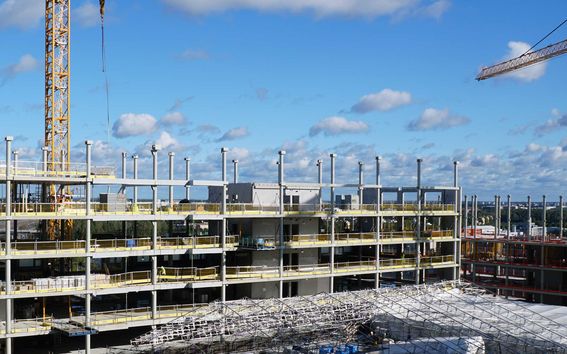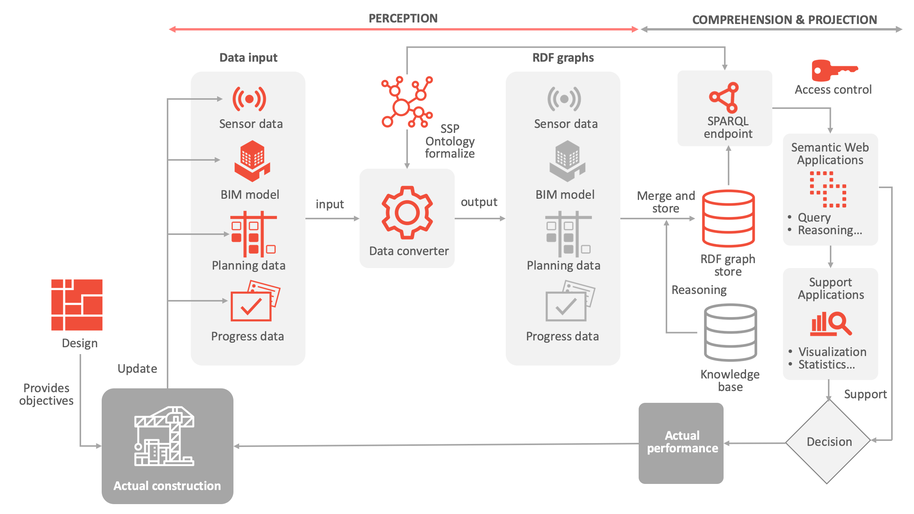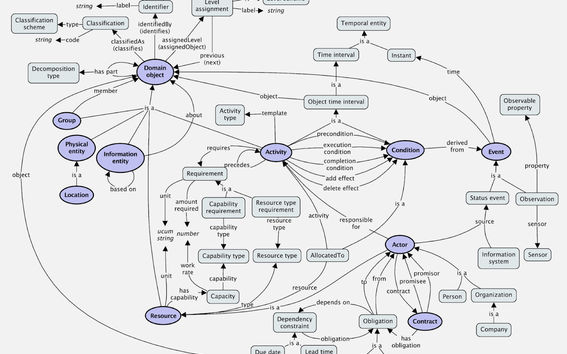DiCtion Ontology Makes Data Flow within a Construction Project

Construction is a knowledge-based and information-intensive industry. The greatest achievements in making the industry more productive through digitalisation have taken place outside the construction site: in design, manufacturing, and retail.
Designers exchange information as building information models, or BIMs, and many manufacturers can make use of digital design data. So far, construction site managers and workers have not benefited much from digitalisation.
Digital information management in construction has focused on physical products. Less effort has gone into process automation and how physical elements relate to workflows, schedules, and resources. As a result, it’s difficult to automatically collect data from various sources to form a real-time situational picture of a construction site.
Situational awareness would help both managers and workers on a construction site to become more productive. It would be of advantage to many functions, including task management and control, logistics, procurement, and safety management.
Why We Need a Shared Data Model
To be able to collect data from various sources and combine it in a meaningful way and without manual interaction, we need a shared data model. DiCtion has created a data model, an ontology, especially for construction processes.
An ontology is a formal description of our knowledge. It ensures a common understanding of how we represent the data of things and processes and resources, and the relationships between them in a certain domain.
For example, the installation of a façade panel will illustrate why having a shared ontology makes sense. The installation supervisor wants to know which panels are to be installed, when those panels will arrive on site, where they must be installed, and in what sequence. The installation worker and the crane operator need to know the exact location of the panel in the building façade. When the panel is in place, the supervisor wants to receive an automated update that the job has been completed.
The installation workflow uses data from the construction schedule, a BIM, the manufacture’s ERP system, the transport company’s logistics system, and the construction site sensor network. Without a shared ontology, it would be difficult to build an automated system for situational awareness of the construction site.

The DiCtion Ontology Development
Yuan Zheng, a doctoral student at Aalto University, is one of the creators of the DiCtion ontology. He explains how it builds on the existing standards of the Semantic Web technology. They include OWL, the Semantic Web Ontology language, and RDF, the Resource Description Framework. The latter is used to describe the links between objects defined in the ontology.
The ontology consists of concepts, such as ‘an activity’ and ‘an actor’, and links that describe their relations. For example, ‘an actor is responsible for an action.’
"The Semantic Web Ontology allows us to make the data machine-readable ‒ to make machines understand the meaning of the information," says Zheng. “It also gives us the ability to integrate with other ontologies and use their concepts.”
He goes on to explain how data from various sources can be gathered and converted into a standard RDF format using the ontology. The data forms a kind of web of the construction site, its processes, and its resources. In fact, every object in the database has its own identifier, a URI.
Construction management applications can make queries of the semantic data. For example, an application could ask if certain rooms in a building under construction are ready for their wood flooring to be laid. The app would query data from the construction schedule, requirements database, humidity sensors, and a BIM. If the relative humidity of the selected floor surfaces is between 45% and 55%, the app could inform the installation team that they can start the job as scheduled.

How to Start Using the Ontology
The ontology is an effort to stabilise the way we represent real-life concepts in data systems. It is useful for construction companies that want to digitalise their workflows. The ontology provides a common language for both internal development and collaboration with technology providers.
Design, construction, and maintenance software developers can apply the ontology to their own products and services. By doing so, their products become interoperable on a contextual level, which is not typically the case with today’s products. A shared ontology also helps create and use the emerging data platforms in construction.
Dr. Seppo Törmä, the CEO of VisuaLynk, is another developer of the DiCtion ontology. He thinks that the use of the ontology will eventually make data useful for everybody on a construction site.
“The way building models and linked data are represented today requires a lot of computing power. It’s not practical to retrieve the whole BIM if you just need information about a single room or a building part,” says Törmä. “Using the ontology, we can quickly receive the detailed information, without the overhead.”
The DiCtion ontology development is not finished. Extensions and refinements will take place in the coming months. Among the tasks on the list are the introduction of object life cycles and levels of development. The use of material kits, quality management concepts, and workspace requirements are also in the pipeline.
Four modules of the construction ontology are currently available on GitHub: Organisation, Monitoring, Objects, and Planning. DiCtion encourages construction companies and technology developers to learn more about the ontology, provide their comments, and start using it.
See the latest version of the ontology at https://digitalconstruction.github.io/.
Read more news

Research Council of Finland establishes a Center of Excellence in Quantum Materials
The Centre, called QMAT, creates new materials to power the quantum technology of coming decades.
Two Unite! Seed Fund projects involving Aalto secure top EU funding
Two prestigious EU grants have been awarded to projects that were initially supported with Unite! Seed Funding. Both projects involve Aalto.
Major funding powers development of next-generation machine technology aimed at productivity leap in export sectors
The BEST research project is developing new types of sealing, bearing, and damping technology.






